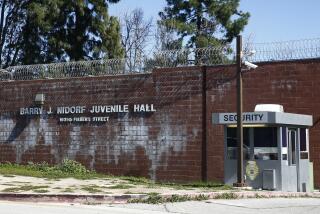Officials Fear U.S. Drug War Funds Inadequate : Narcotics: Little of the $10.6 billion in Bush’s plan appears likely to reach street officers. Addicts may receive more help.
For a year now, Los Angeles officials have been lobbying for more federal drug-fighting funds and designation as a “high-intensity” drug-trafficking center, using as ammunition everything from a record $100 million in cash seizures to the astounding discovery of 21 tons of cocaine in a Sylmar warehouse.
On Thursday, the officials finally got the designation they wanted, but the reaction was mixed--their enthusiasm tempered by lack of a specific list of the help they will get and debate over whether a special $25-million fund to be shared by five target areas nationwide is merely a “drop in the bucket.”
And, hours after President Bush outlined his $10.6-billion anti-drug plan, a group of police officers at one of Los Angeles’ drug “supermarkets” wondered whether any of it would filter down to them.
“Most off all we need new radios,” said Sgt. Dave Cullen, part of a Los Angeles police narcotics crew making one of its periodic sweeps through MacArthur Park.
Although few details were of the plan were released, it appeared that little if any of the funds would go directly to local law enforcement agencies. Instead, officials said 300 additional agents and support personnel would be added to Los Angeles offices of federal agencies such as the Drug Enforcement Administration and Customs Service, which would benefit Orange County in its battle against drugs. Another 694 positions would be added in the vast “Border States region,” which includes San Diego and Imperial counties in California.
Officials predicted the creation of more task forces combining DEA agents with officers from local agencies to tackle problems such as street gang drug traffickers, clandestine desert landing strips used by smugglers and money laundering.
In addition, California should get thousands more “treatment slots” for drug addicts and “a substantial portion” of 75 new federal judgeships called for under the Bush Administration’s overall anti-drug plan, according to Chauncey Veatch, chairman of the Governor’s Policy Council on Drug and Alcohol Abuse.
“Whether $25 million appears to be a drop in the bucket or not, we are grateful,” Veatch said. “The announcement is something we have long awaited . . . . This will be the area of America where the war is fought. Our opportunity for more resources down the road will grow.”
But Rep. Howard L. Berman (D-Panorama City) called the funding “woefully inadequate,” adding, “I really wish the Administration had done this a year ago. We’ve lost a lot of ground while the ‘drug czar’ (William J. Bennett) studied what was patently obvious.”
Under the federal plan, Los Angeles and the four other target zones--the border area, New York, Miami and Houston--would get increased funding in two ways: first, through a yet-undetermined split of the $25 million along with up to $21 million more from the federal asset forfeiture fund; and second, through increases in the regular federal budget for law enforcement agencies, treatment programs and the like.
In the second category, the Los Angeles area would receive $169 million in fiscal 1991, 11% more than the current $151 million.
In citing Los Angeles as one of the target areas, the 142-page National Drug Control Strategy called it “a major entry and transshipment point for cocaine, Asian and Mexican heroin and marijuana” and the base of street gangs that sell drugs around the nation.
The precise boundaries of the target areas are still to be determined, the report said, “through consultation with local officials,” and this area “could include Los Angeles County and Orange County, and all the municipalities therein.”
“I’m ecstatic,” said Orange County Sheriff Brad Gates, who had pushed for inclusion in such a zone and was in Washington to attend a White House briefing on the President’s plan.
“It will give us additional federal prosecutors who can help us work these (drug) cases,” Gates said.
His sentiments were echoed by police chiefs of several Orange County cities. But several also expressed the hope that the money will quickly find its way to the local level.
“This is a good first step, but the whole aim should be to get the funds to the cities where the drug war is being fought,” said Santa Ana Police Chief Paul Walters. “The money should not be funneled in to the bureaucracy alone.”
Among the proposals mentioned in the report’s discussion of the target zone along the Mexican border was one to improve or redesign the Immigration and Naturalization Service border checkpoint on Interstate 5 south of San Clemente.
Officials from the Justice Department would be named to coordinate the distribution of funds in each of the target areas except the border, where a Treasury Department official would preside.
Los Angeles officials have waged a sustained campaign for more federal aid, spotlighting the city’s growing role as a drug-trafficking center and complaining of an East Coast bias in allocation of drug-fighting funds. State Atty. Gen. John K. Van de Kamp belittled federal aid proposals by comparing them to someone offering help with a garden hose while his neighbor’s house is burning down.
The Los Angeles campaign got a boost in August, when a report by U.S. Atty. Gen. Dick Thornburgh described an alliance between the Colombian drug cartels and Los Angeles street gangs.
On Dec. 29, the Department of Justice awarded California $39.7 million in anti-drug funds, nearly four times the amount granted the previous year, with 64% going to cities and counties.
In MacArthur Park, there was little time to ponder what it all would mean after a caravan of five police cars descended Thursday afternoon on a popular crack dealing spot.
“You see this here,” said Sgt. Raul Amescua, pulling a wad of bills--$693 in all--from the pants pocket of a 22-year-old suspect.
A crowd of transients, some with shopping carts and garbage bags with their belongings, watched as two rows of men and women stood with their hands behind their heads.
Some waited anxiously for the policemen to leave so they could “tweek,” scrounge the ground for rocks of cocaine dropped during the raid and overlooked by the officers.
“A lot of these people here are down and out. They’re addicted and they need a place to go,” Amescua said. Without major increases in treatment programs, he predicted, “most of them will live their lives just the way they’re living it now.”
But one onlooker, a 27-year-old transient originally from New York, said there was nothing the government could do to change his addiction to “hitting the pipe.”
“Treatment centers just let your mind sleep,” he said. Then you wake up one day “and you have to have it.”
As the officers pulled away, he joined two dozen others in a frenzied search along the ground.
Times staff writers Davan Maharaj and Robert Stewart contributed to this report.
More to Read
Sign up for Essential California
The most important California stories and recommendations in your inbox every morning.
You may occasionally receive promotional content from the Los Angeles Times.










